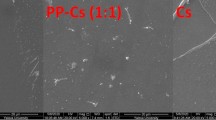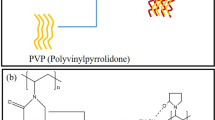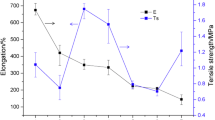Abstract
CS/PVP blend membranes at different weight ratios were fabricated using a solution casting method and were characterized by measuring thickness, mechanical properties, water vapour transmission rate (WVTR), and water solubility. Membrane morphology and other characteristics were analysed using scanning electron microscopy, X-ray analysis, DSC, TGA, and ATR-FTIR spectroscopy. SEM and XRD showed that the CS/PVP was homogeneously dispersed in the membrane and the crystallinity decreased with increasing PVP content. The prepared membranes also showed good thermal properties. The strong interaction between the Chitosan and PVP contributed to improvement in the properties of the blend membranes. Membranes with CS/PVP = 1/1 blend ratio of chitosan/PVP showed the most satisfactory Hemolysis, TS, Elongation at break of all tested ratios. The antibacterial activity of the blend membranes was then investigated against Gram-negative Pseudomonas aeruginosa and Gram-positive Staphylococcus aureus. The PVP concentration contributes to antibacterial effect of the membranes and lower water vapour transmission rate. The in vitro hemolysis test of the membranes showed blood compatibility. These findings suggest that the CS/PVP as a promising material for biomedical application.











Similar content being viewed by others
References
Archana D, Singh BK, Dutta J, Dutta PK (2014) Chitosan- PVP-nano silver oxide wound dressing: in vitro and in vivo evaluation. Int J Biol Macromol 10:10–55
Lim JI, Kang MJ, Lee W-K (2014) Lotus-leaf-like structured chitosan–polyvinyl pyrrolidone films as an anti-adhesion barrier. Appl Surf Sci 320:614–619
Maria JA, Oliveira MJ, Valdir S (2015) Drug delivery glucantime in PVP/chitosan. Membranes 85:4–9
Archana D, Dutta J, Dutta PK (2013) Evaluation of chitosan nano dressing for wound healing: characterization, in vitro and in vivo studies. Int J Biol Macromol 57:193–203
Yang Y, Tang H, Kowitsch A (2014) Novel mineralized heparin–gelatin nanoparticles for potential application in tissue engineering of bone. J Mater Sci Mater Med 25:669–680
Sapir Y, Kryukov O, Cohen S (2011) Integration of multiple cell-matrix interactions into alginate scaffolds for promoting cardiac tissue regeneration. Biomaterials 32:1838–1847
Lee JS, Baek SD, Venkatesan J (2014) In vivo study of chitosan natural nano hydroxyapatite scaffolds for bone tissue regeneration. Int J Biol Macromol10:1–24
Takei T, Sugihara K, Yoshida M, Kawakami K (2013) Injectable and biodegradable sugar beet pectin/gelatin hydrogels for biomedical applications. J Biomater Sci Polym Ed 10:1333–1342
Nie J-J, Zhao W, Hao H, Bingran Y, Fujian X (2016) Controllable heparin based comb copolymers and their self-assembled nanoparticles for gene delivery. Acs Appl Mater Interfaces 10:1–41
Nakasone K, Ikematsu S, Kobayashi T (2015) Biocompatibility evaluation of cellulose hydrogel film regenerated from sugarcane bagasse waste and its in vivo behavior in mice. Ind Eng Chem Res 10:1–29
Rodríguez-Vázquez M, Vega-Ruiz B, Ramos-Zúñiga R (2015) Chitosan and its potential use as a scaffold for tissue engineering in regenerative medicine. Bio Med Res Int 15:1–15
Zhang J, Xia W, Liu P (2011) Chitosan modification and pharmaceutical/biomedical applications. Mar Drugs 8:1962–1987
Qian L, Zhang H (2012) Green synthesis of chitosan-based nanofibers and their applications. Green Chem 10:1–8
El Hadrami A, Adam LR (2010) Chitosan in plant protection. Mar Drugs 8:968–987
Sanders WC (2015) fabrication of polyvinylpyrrolidone micro-/nano structure utilizing microcontact printing. J Chem Educ 10:1–5
Ramadass SK, Perumal S, Gopinath A (2014) Sol−gel assisted fabrication of collagen hydrolysate composite scaffold: a novel therapeutic alternative to the traditional collagen scaffold. ACS Appl Mater Interfaces 6:15015–15025
Mansur HS, Ezequiel de S. Costa, Alexandra AP, Mansur (2009) Cytocompatibility evaluation in cell-culture systems of chemically crosslinked chitosan/PVA hydrogels. Mater Sci Eng C 29:1574–1583
Velásquez-Cock J, Ramírez E, Betancourt S (2014) Influence of the acid type in the prouction of chitosan films reinforced with bacterial nanocellulose. Int J Biol Macromol 69:208–213
Dash M, Chiellini F, Ottenbrite RM, Chiellini E (2011) Chitosan—a versatile semi-synthetic polymer in biomedical Applications. Prog Polym Sci 36:981–1014
Stoica P, Chifiriuc MC (2015) Fabrication, characterization and bioevaluationof novel antimicrobial composites based on polycaprolactone, chitosan and essential oils. Rom Biotechnol Lett 20:10521–10533
Mehta A, Kanungo I, RaghavaRao J, Nishad Fathima N (2015) Micro environmental changes in collagen/polyvinyl alcohol blends in the presence of ionic liquid: a spectroscopic analysis.J. Bioact Compat Polym 10:1–11
Thankam FG, Muthu J, Sankar V (2013) Growth and survival of cells in biosynthetic poly vinyl alcohol–alginate IPN hydrogels for cardiac applications. Colloids Surf B.107:137–145
Abdelrazek EM, Elashmawi IS, Labeeb S (2010) Chitosan filler effects on the experimental characterization, spectroscopic investigation and thermal studies of PVA/PVP blend films. Phys B 405:2021–2027
Sakurai K, Maegawa T, Takahashi T (2000) Glass transition temperature of chitosan and miscibility of chitosan/poly (N-vinyl pyrrolidone) blends. Polymer 41:7051–7056
Doulabi AH, Mirzadeh H (2013) Chitosan/polyethylene glycol fumarate blend film: physical and antibacterial properties. Carbohydr Polym 92:48–56
Wang H, Zhang R, Zhang H, Jiang S (2015) Kinetics andfunctionaleffectiveness of nisin loaded antimicrobial packaging film based on chitosan/poly (vinyl alcohol). Carbohydr Polym 127:64–71
Costa-Júnior ES, Barbosa-Stancioli EF, Mansur AA (2009) Preparation and characterization of chitosan/poly (vinyl alcohol) chemically crosslinked blends for biomedical applications. Carbohydr Polym 76:472–481
Dhawade Prerna P, Jagtap Ramanand N (2012) Characterization of the glass transition temperature of chitosan and its oligomers by temperature modulated differential scanning calorimetry. Pelagia Res Library 3:1372–1382
Haaf F, Sanner A (1985) Polymers of N-vinylpyrrolidone: synthesis, characterization and uses. Polym J 17:143–152
Duan W, Chen C, Jiang L (2008) Preparation and characterization of the graft copolymer of chitosan with poly[rosin-(2-acryloyloxy)ethyl ester]. Carbohydr Polym 73:582–586
Zhong Q-P, Xia W-S (2008) Physicochemical properties of edible and preservative films from chitosan/cassava starch/gelatin blend plasticized with glycol. Food Technol Biotechnol 46:262–269
Higa OZ, Rogero SO, Machado LDB, Mathor MB (1999) Biocompatibility study for PVP wound dressing obtained in different conditions. Radiat Phys Chem 55:705–707
Author information
Authors and Affiliations
Corresponding author
Rights and permissions
About this article
Cite this article
Poonguzhali, R., Basha, S.K. & Kumari, V.S. Synthesis and characterization of chitosan/poly (vinylpyrrolidone) biocomposite for biomedical application. Polym. Bull. 74, 2185–2201 (2017). https://doi.org/10.1007/s00289-016-1831-z
Received:
Revised:
Accepted:
Published:
Issue Date:
DOI: https://doi.org/10.1007/s00289-016-1831-z




